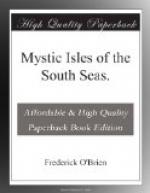They were believers in the doctrines of Leo Tolstoi, and especially in non-resistance, and the possessing little or no property to encumber their free souls. In the village they had become the guides of the Tahitians in the devious path of enforced civilization.
Mrs. Lermontoff, in lamenting the Tahitian’s degradation, physical and spiritual, said that she was reminded always of the Innuit, the Eskimo, among whom she and her husband had passed several years.
“They are the most ethical, the most moral, the most communal people I know of,” she commented. “They have a quality of soul higher than that of any other race, a quality reached by their slow development and constant struggle. I imagine they went through a terrible ordeal in the more temperate zones farther south before they consented to be pushed into the frozen lands of Canada, and then, following the caribou in the summer, to mush to the Arctic sea. There, while they had to change their habits, clothing and food, to learn to live on the seal and the bear and the caribou in the midst of ice and snow, they were spared for thousands of years the diseases and complexes of civilization, and reached a culture which is more worth while than ours.”
I was skeptical, but she quoted several eminent anthropologists to support her statement that the Eskimo were better developed mentally than other people, and that in simplicity of life, honesty, generosity, provision for the young and the old, in absence of brutality, murder and wars, they had a higher system of philosophy than ours, which admits hells, prisons, asylums, poor houses, bagnios, famines and wars, and fails even in the recurrent periods of hard times to provide for those stricken by their lash.
“But,” said Lermontoff, “the Innuit, too, is corrupting under the influence of trade, of alcohol, and the savage lust of the white adventurer. He attained through many centuries, perhaps thousands of years, of separation from other peoples, and without any of the softening teachings of Christianity, a Jesus-like code and practice, which the custodians of Christianity have utterly failed to impress on the millions of their normal adherents.”
I looked out upon the reef where the waves gleamed faintly, upon the scintillating nearer waters of the lagoon, and upon us, barefooted, and clothed but for decency, and I had to jolt my brain to do justice to the furred and booted Eskimo in his igloo of ice. The difference in surroundings was so opposite that I could barely picture his atmosphere climatological and moral. I led the conversation back to their situation in Vaieri.
He had planted his vanilla-vines on coffee-bushes, the vanilla being an orchid, a parasite, that creeps over the upstanding plants, coffee, or the vermillion-tree. Lermontoff said that it was a precarious crop, a world luxury, the price of which fluctuated alarmingly. Yet it was the most profitable in Tahiti, which produced half of all the vanilla-beans in the world.




